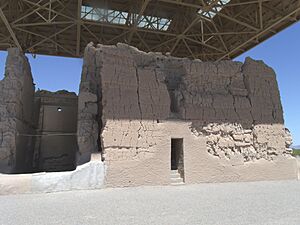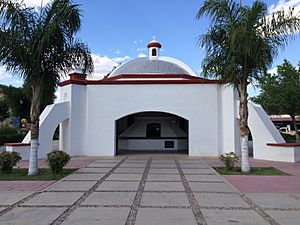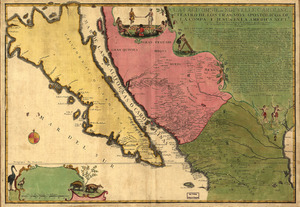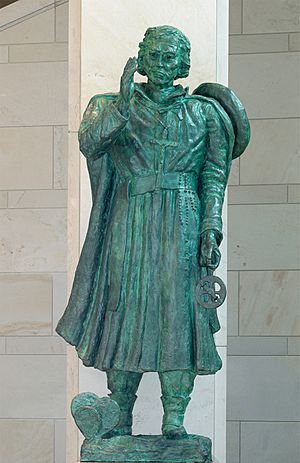Eusebio Kino facts for kids
Quick facts for kids Servant of GodEusebio Francisco Kino |
|
|---|---|

Equestrian statue in his birthplace of Segno
|
|
| Priest; Missionary; Explorer | |
| Born | Eusebio Francesco Chini 10 August 1645 Segno, Bishopric of Trent, Holy Roman Empire (now Predaia, Trentino, Italy) |
| Died | 15 March 1711 (aged 65) Mission Santa Maria Magdalena, Pimería Alta, New Spain (now Magdalena de Kino, Sonora, Mexico) |
| Venerated in | Catholic Church |
Eusebio Francisco Kino (born August 10, 1645 – died March 15, 1711) was an Italian Jesuit priest, missionary, and explorer. He was also a geographer, mapmaker, and astronomer. He was born in what is now Italy, but was then part of the Holy Roman Empire.
For the last 24 years of his life, Kino worked in a region called the Pimería Alta. This area is now Sonora in Mexico and southern Arizona in the United States. He explored this land and worked with the local Native American people. These included the Tohono O'Odham, Sobaipuri, and other Piman groups.
Kino proved that the Baja California Peninsula was not an island. He did this by leading a trip there over land. By the time he died, he had started 24 missions and visitas (small chapels).
Contents
Kino's Early Life and Studies
Kino was born Eusebio Chini in a village called Segno. This village is now part of Predaia, Italy. When he was young, he got very sick. After he got better, he added "Francesco" to his name. This was to honor Saint Francis Xavier.
His parents were Franz Kühn and Margherita Luchi. They came from important local families. We don't know his exact birth date, but he was baptized on August 10, 1645.
Kino went to school in Innsbruck, Austria. After his illness, he joined the Society of Jesus on November 20, 1665. From 1664 to 1669, he trained to be a Jesuit. He studied in Freiburg, Ingolstadt, and Landsberg, Germany. He also taught math in Ingolstadt. He became a priest on June 12, 1677.
Kino wanted to travel to Asia, but he was sent to New Spain (which included Mexico). He missed his ship and had to wait a year for another one. While waiting in Cádiz, Spain, he studied a comet (Kirch's comet). He wrote a book about it called Exposición astronómica de el cometa.
Adventures in Baja California
Kino's first job was to lead an expedition to the Baja California peninsula. This area was part of New Spain. In 1683, he started the Misión San Bruno.
But there was a long period without rain in 1685. Because of this drought, Kino and the other missionaries had to leave the mission. They went back to Mexico City.
Missions in Pimería Alta

Father Kino started his work in the Pimería Alta on March 14, 1687. This was 24 years and one day before he died. He left Cucurpe, a town once known as the "Rim of Christendom."
When Father Kino arrived in Pimería Alta, the native people asked him to build a mission. He quickly started the first one in a river valley in Sonora's mountains.
Kino then traveled across northern Mexico and into what is now California and Arizona. He used old trading paths that native people had used for thousands of years. These paths later became roads.
He rode over 50,000 square miles (130,000 km2) and mapped a huge area. His maps were the most accurate for over 150 years after he died. Many places, like the Colorado River, were first named by Kino.
Kino also helped the area's economy grow. He worked with the native people who already farmed. He taught them about European seeds, fruits, herbs, and grains. He also showed them how to raise cattle, sheep, and goats. Kino brought 20 cattle to Pimería Alta. By the time he left, there were 70,000 cattle! Some people call Kino Arizona's first rancher.
Working with Native Tribes
During his travels in Pimería Alta, Father Kino met with 16 different tribes. Some of these tribes lived near Piman lands. Others traveled to meet Kino. Sometimes, Father Kino went into their lands to visit them.
The tribes Kino met included the Cocopa, Eudeve, Hia C-ed O'odham, Kamia, Kavelchadon, Kiliwa, Maricopa, Mountain Pima, Opata, Quechan, Gila River Pima, Seri, Tohono O'odham, Sobaipuri, Western Apache, Yavapai, and Yaqui.
Kino's Other Interests
Kino was against slavery and forced labor in the silver mines. The Spanish made native people work in these mines. This caused arguments with other missionaries. Many of them followed the laws set by Spain.
Kino was also a writer. He wrote books about religion, astronomy, and cartography. He built missions from Mexican Sonora northeast into Arizona. The San Xavier del Bac mission near Tucson is still a church today. Kino built 19 rancherías (villages) that provided cattle to new settlements.
Father Kino was an expert astronomer, mathematician, and mapmaker. He drew the first accurate maps of Pimería Alta, the Gulf of California, and Baja California.
He also enjoyed making model ships from wood. His knowledge of maps and ships made him believe that Mexican native people could easily reach California by sea. Other missionaries in Mexico City doubted this. Kino even started building a boat that would be pulled across the Sonoran Desert. This made some of his fellow missionaries question his ideas.
Kino had more money than most missionaries. He used it mainly to pay for his missionary work. Some people at the time were suspicious of his wealth.
Kino's Death

Kino stayed with his missions until he died in 1711. He passed away from a fever on March 15, 1711, at age 65. This happened in what is now Magdalena de Kino, Sonora, Mexico. You can see his bones in his crypt, which is a national monument in Mexico.
Kino's Legacy
Kino has been honored in both Mexico and the United States. Many towns, streets, schools, monuments, and places are named after him. The mineral Kinoite is also named in his honor.
In 1965, a statue of Kino was given to the United States Capitol's National Statuary Hall collection. It is one of two statues representing Arizona. Another statue of him stands above Kino Parkway in Tucson. An equestrian statue (a statue of a person on a horse) of Kino is in Wesley Bolin Memorial Plaza in Phoenix, Arizona. There's also an equestrian statue next to the Cathedral in Hermosillo, Sonora, Mexico.
The towns of Bahía Kino and Magdalena de Kino in Sonora, and Ejido Padre Kino in Baja California, are named after him. A park with a Kino statue is in Nogales, AZ. The largest statue of Kino is along the US-Mexico border in Tijuana, Baja California. There's even a wine named after him!
In 2009, Jesuit groups and Catholic dioceses started the Kino Border Initiative. This group helps migrants in Nogales, Arizona, and Nogales, Sonora. It is named in his honor. In 2015, a monument to Kino was put in a garden in Trento, Italy. In 1963, he was added to the Hall of Great Westerners.
Missions and Settlements Kino Founded
After Christopher Columbus's first trip, the Catholic Church gave the lands of "New Spain" to the Spanish Crown. The Crown was told to help convert the native people to Catholicism. These lands included the Caribbean, Mexico, and parts of what is now the Southwestern United States.
In these new lands, the Spanish Crown used three main ways to expand its control:
- The presidio (royal fort)
- The pueblo (town)
- The misión (mission)
There were also asistencias (sub-missions). These were smaller missions that had church services regularly but did not have a priest living there. Visitas (visiting chapels) also did not have a priest living there. They were often visited only sometimes. These settlements were built so that each one was no more than a day's ride by horse or boat from another.
Each frontier station had to support itself. This was because there were no supply lines (roads). It was impossible to get supplies from outside. To keep a mission going, the priests needed Spanish settlers or converted native people. They had to grow crops and raise animals to support the church. Since imported materials and skilled workers were rare, the priests used simple building materials and methods.
The Spanish leaders thought the missions were temporary. But starting a mission followed strict rules. The paperwork took months, sometimes years, and involved many levels of the Spanish government.
Once a mission could be built in an area, the priests chose a good spot. It needed a good water supply, plenty of wood for fires and building, and fields for animals and crops. The priests blessed the site. With help from soldiers, they built temporary shelters. These were made of tree branches with roofs of thatch, reeds, or saguaro ribs. These simple huts later became the stone and adobe buildings we see today.
Most buildings and even whole villages were built facing east-west. This was to get the best light from the sun inside. Spanish rules said that villages should be on the west side of any valley. This way, the sun would shine into homes first thing in the morning. This was meant to stop people from being lazy.
When starting a mission, the church's spot was chosen first. Then the rest of the mission complex was planned. Workshops, kitchens, living areas, and storage rooms were usually grouped in a square. Religious celebrations and other events could take place inside this square.
List of Missions and Visitas
This is a list of some of the places Kino helped to found:
- Nuestra Señora de Guadalupe: Started in April 1683 near La Paz, Baja California. It was left after four months.
- Mission San Bruno: Started October 1683. Left in September 1685 due to a long drought.
- Mission Nuestra Señora de los Dolores: Started March 13, 1687. This was Father Kino's first mission in Pimería Alta. It was left by 1744.
- Nuestra Señora de los Remedios: Started in 1687 and left by 1730. Nothing remains of it.
- San Ignacio de Cabórica: Started in 1687 in San Ignacio, Sonora.
- Mission San Pedro y San Pablo del Tubutama: Started in 1687, in Tubutama, Sonora.
- Santa Teresa de Atil: Started in 1687, in Atil, Sonora.
- Santa Maria Magdalena: Started in 1687, in Magdalena de Kino, Sonora. Kino's grave is here.
- San José de Imuris: Started in 1687, in Imuris, Sonora.
- Nuestra Señora del Pilar y Santiago de Cocóspera: Started in 1689. It is in Cocóspera, Sonora.
- San Antonio Paduano del Oquitoa: Started in 1689. It is in Oquitoa, Sonora.
- San Diego del Pitiquito: Started in 1689. It is in Pitiquito, Sonora.
- San Luis Bacoancos: Started in 1691, but soon left after Apache attacks.
- Mission San Cayetano del Tumacácori: Started in 1691. This was southern Arizona's first mission. Later, a chapel was built.
- Mission San José de Tumacácori: This is now a National Historic Park. It was left by 1840.
- La Misión de San Gabriel de Guevavi: Started in 1691. It became a main mission in 1701. Its name changed many times. Its ruins are part of Tumacácori National Historical Park.
- San Lázaro: Started in 1691, but soon left after Apache attacks.
- San Xavier del Bac: 16 miles south of Tucson, Arizona. Started as a mission location in 1692. The current building is from 1785. It is still used by Tohono O'odham Nation members.
- Visita San Cosme y Damián de Tucson: Started 1692.
- Visita Los Santos Reyes de Sonoita/San Ignacio de Sonoitac: A rancheria near Tumacacori, started 1692.
- Visita San Martín de Aribac: A rancheria 25 miles west of Tumacacori, started before 1695.
- La Purísima Concepción de Nuestra Señora de Caborca: Started 1693.
- Santa María Suamca: Started 1693.
- San Valentín de Busanic/Bisanig: Started 1693.
- Nuestra Señora de Loreto y San Marcelo de Sonoyta: Started 1693.
- Nuestra Señora de la Ascención de Opodepe: Started 1704.
Movies About Kino
- Father Kino, Padre on Horseback (also called Mission to Glory: A True Story) was made in 1977. Richard Egan played Kino.
- Kino: La leyenda de Padre Negro (Kino: The Legend of the Black Robe Priest) was made in 1993. Enrique Rocha played Kino. This movie won an award for its music.
Books About Kino
- In John Steinbeck's book, The Pearl, the main character might be named after Kino. This shows how much European culture impacted the area.
- In Philip Caputo's 2017 book Some Rise by Sin, there is a statue of Father Kino in a Mexican churchyard. The main character thinks about Kino's life.
Images for kids
-
Equestrian statue of Father Kino in front of the Arizona State Capitol in Phoenix, Arizona
See also
 In Spanish: Eusebio Francisco Kino para niños
In Spanish: Eusebio Francisco Kino para niños





